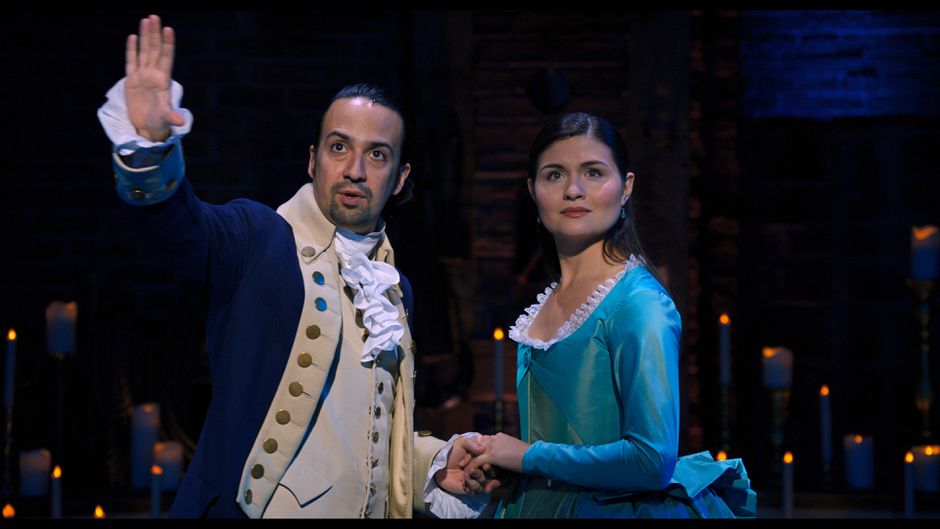With Disney+ purchases skyrocketing 72% this past weekend, you can bet your friends and family were watching Hamilton (if it wasn’t on in your own living room). The “Hamilton” movie, featuring the original cast (including Miranda in the title role), is a “live” recording of the musical captured via nine cameras as it appeared on stage in New York in 2016. Read on to learn entertainment and pop culture site, The AV Club‘s, take on how the live-action play translated to the big screen.
Today the world knows a lot more about the intensity of Jonathan Groff’s enunciation than it did yesterday. Over the course of two performances in 2016, nine cameras captured Hamilton, Lin-Manuel Miranda’s juggernaut musical retelling of the life of America’s first secretary of the treasury, in intimate detail. Groff, who plays King George III, tears into the role he originated and his consonants with equal relish, and the spit flies. It’s not hard to imagine this Hamilton someday reaching movie screens with a 3D conversion: the two-story set looming, the bayonets jutting, the spittle triumphantly spraying—just like it did in the Richard Rodgers Theatre, and just as it will again someday when both cinemas and theaters re-open, the audience at a safe remove.
The mention of Groff’s moist diction isn’t intended to turn stomachs. Nor is it a piece of oddball minutiae. It’s a mark of the spirit of this filmed version of Hamilton, which arrived today on Disney+. Directed by Thomas Kail (FX’s Fosse/Verdon), also the director of Hamilton’s original Off-Broadway and Broadway runs, this is an experience that revels in such details. It’s also perhaps the apex expression in a long tradition of capturing live theater, dance, and opera for the screen, one that includes the canon captured by Great Performances and American Playhouse, impressive big-screen recordings from the U.K.’s National Theatre Live, and filmed concert-style performances like the 1995 “dream cast” version of Les Misérables. Here, the “dream cast” is the original cast; the number of people who’ll get to see Miranda in the role—and take in the performances that made stars of Leslie Odom Jr., Daveed Diggs, and others—just skyrocketed.
It’s a rarity, to see a play or musical captured this way; usually, the treatment is afforded to starrier productions and huge financial/critical hits. (The Bernadette Peters-led original cast take on Into The Woods was a staple of this writer’s childhood, as was a production of Our Town featuring Spalding Gray.) As a viewing experience, they’re of immense value, recording for posterity some once-in-a-lifetime performances from world-class actors and, as a bonus, lending a sense of immediacy and intimacy with the material that not even an original cast recording can offer. As a means of capturing the experience of being there—in the room where it happens, as it were—they are always a failure. Theater is a live artform, its ephemeral nature the source of its magic.
It’s unwriterly to say that the precise wonder of a theatrical experience can’t be easily articulated, but it’s true all the same. Broadly speaking, theater is something we experience communally. You can’t replicate seeing a movie in a crowded theater from your living room; with theater, that difficulty is heightened because the communal experience actually involves the actors. (Imagine seeing John Wick and knowing Keanu Reeves can hear and by fed by your every gasp; imagine watching Bridesmaids and seeing Melissa McCarthy hold for laugh after laugh, the pauses somehow enriching the jokes.)
Yet this attempt, this Hamilton time capsule, comes perhaps as close to capturing that magic of live theater as any such effort, not least because Kail and company went so far as to mic the audience’s reactions—the roar that goes up after Diggs and Miranda say, “Immigrants: We get the job done,” is now preserved for all time. It’s an experience that exists somewhere between a concert film and a remarkably accomplished home movie shot by some proud parents chronicling the time Miranda starred in the school play (if Miranda also wrote this school play, and it went on to win a Pulitzer and 11 Tony Awards). The latter comparison is not meant as a slight. It’s clear that Kail, director of photography Declan Quinn, editor Jonah Moran, and the technical teams behind both the stage production and film approached this project with tremendous thought and affection, aiming to bottle some small piece of the magic of seeing the show live while also taking great advantage of the medium with which it’s being captured. Kail in particular possesses a lens like no other, and it’s one he lends the viewer here: that of someone who’s seen Hamilton hundreds of times, whose intimacy with the production is unparalleled, and who knows just where to look for every small, perfect moment.
Also on Coast to Coast
-
Episode 23 of Coast to Coast: Exploring Disneyland’s Pixar Pier & the Best Frozen Foods with Chef Jamie Gwen
-
Coast to Coast Sets Sail on Royal Caribbean’s Icon of the Seas
-
Discovering Amazing Ways to Make a Splash at Disney’s Aulani Resort
-
Family Fun at Disneyland’s Aulani Resort
-
Checking Out the Delicious Dining Options at Disney’s Aulani Resort!
